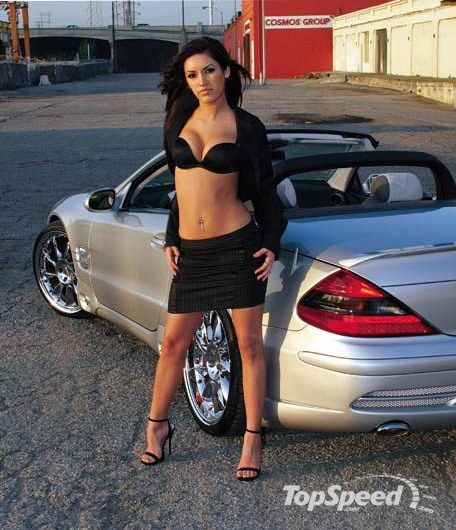
Brush your long, grungy mop from your eyes, turn down the Nirvana and take a look around. It's the early '90s and an army of sport utility vehicles are flooding the streets. The newest four-wheeled object of America's affection has quickly become the default mode of transportation for everyone from inner city professionals to suburban soccer moms.
Fast forward a couple of decades and although sport utes are still around, they've largely been displaced by the crossover – the SUV's easier-to-maneuver, more fuel efficient and more comfortable unibody progeny. But even after years of refinement, the CUV is still a basketcase of compromises. Which begs the question: Did we have it right back in the day? Is a wagon still the best compromise of size, functionality and driving dynamics? We snagged the keys to a 2011 Acura TSX Sports Wagon to find out.
Needless to say, the TSX Sport Wagon is based on its sedan counterpart, but in addition to its two-box shape, Acura has set it off with a redesigned grille. The new piece looks far less hawk-nosed than the one worn by the four-door, as its been broken up by a thinner frame that creates a slimming effect. The lower bumper also improves front-end styling with a much wider and more aggressive appearance. Seeing the TSX Sport Wagon for the first time is a bit like running into that formerly plain-looking girl from high school who got some work done and now dates a pro baseball player; she looks nearly the same, but somehow better. And she knows it. All of which suggests that Acura's stylists may have been listening to at least some of the criticism they've received over the company's controversial front fascia.
The Sport Wagon's updated nose gives way to that long wagon body, which also benefits from a handful of well-placed styling elements. Noticeable fender bulges wrap around the 17-inch five-spoke aluminum wheels and serve to bookend a razor sharp shoulder crease. A strong character line takes over and works its way around the perimeter of the car. It's a neat visual trick that keeps your eyes moving along the bodywork, and it also helps to hide the extra length the wagon wears – a grand total of about 3.6 inches. The overall appearance, however, is somewhat sportier than the sedan because of how the rotund rear end sets off the car's stance.



The driver's perch gives you the chance to enjoy the TSX's dark trim and subtle contrast stitching on its seats. The heated leather front chairs wrap around your body like a mold and while the Audi A4 Avant, BMW 328i Sport Wagon and Volvo V50 might have nice seats, none of them offer standard heating and few are as comfortable. Rear seat passengers are well taken care of, too, as the wagon loses just 0.1-inch of headroom compared to the sedan, while leg, hip and shoulder room all remain the same.
Better still, the rear seats fold down nearly flat with the touch of a switch. The side pockets and lower panels can be removed to reveal even more storage options and the 28-inch height of the rear opening allows for some sizable objects to catch a lift. The 60.5 cubic-feet of rear cargo space is downright cavernous compared to the 50.5, 48.9 and 44.2 found in the Audi, BMW and Volvo, respectively. The closest you'll get to equaling the TSX's cargo hold is the Cadillac CTS Wagon which comes in at 58 cubes with the seats folded flat.




It's not just comfort and utility that makes the TSX Sport Wagon a near ideal place to log trips over the hills and through the woods. All of the knobs and switches are easy to reach, and the available infotainment system hits the moving target of today's technological standards. With the exception of the bulbous multi-directional controller blighting the center stack, the controls are logically laid out, providing an easy learning curve. Dual-zone climate controls keep more than just the driver happy and even the base seven-speaker sound system provides an enjoyable audio experience. The navigation system and rearview camera, however, only show up on the dashboard if you opt for the Technology Package, but Bluetooth and USB audio come standard.
The base model starts at $30,960 plus $860 for destination and handling, while the TSX Sport Wagon with Tech Package costs $34,610 plus D&H. When upgrading to the latter, buyers also receive a power-actuated tailgate, boosted ELS 460-watt 10-speaker audio system with voice recognition, navigation with real-time weather, traffic updates and dynamic re-routing, and the rearview camera. A loaded Acura TSX Sport Wagon with Tech Package still comes in under the base price of the A4 ($35,940), 328i ($36,200) and comparably-equipped V50 ($35,650). The Caddy? Just over $38,000 in base spec.




Comparing pricing and amenities never paints a complete picture, though, and that's where driving dynamics come into play. "Sport" is the TSX Sport Wagon's middle name, and after hauling around Southern California for a couple of days, the moniker is well-deserved. If just. The suspension is firm – almost surprisingly so – making this five-door a joy to push hard, at least on SoCal's smooth roads. The rack-and-pinion steering is also tight and responsive, combining neatly with the TSX's stiff suspenders to make for an engaging driving experience.
When the road turns even slightly rough, however, the TSX Sport Wagon transforms into something of a child's moonbounce. While never unsettled, on certain course surfaces we found the Acura to be not unlike navigating a Boston whaler across a choppy harbor. Suspension for this front-wheel drive wagon is composed of double wishbones up front and multi-link setup in the rear, and we suspect the issue lies with the constant-rate coil springs. Perhaps a set of progressive units would help smooth things out, but prospective buyers who live in areas blessed with four distinctly separate seasons should keep the TSX Sport Wagon's stiff nature in mind.




Under the hood of the TSX Sport Wagon lies a 2.4-liter four-cylinder producing 201 horsepower at 7,000 rpm and 172 pound-feet of torque at 4,300 rpm. That doesn't sound like much, but the powertrain actually provides a surprising amount of motivation for this 3,599-pound premium utility sled and sounds pretty good while doing it.
Power is routed to the front wheels courtesy of a five-speed automatic transmission, while a pair of paddles mounted to the steering wheel allow for manual gear selection. When left alone, the automatic shifts smoothly, though sometimes it plays a game of hide-and-seek when pressing on with authority. If you're not in the mood for the cogbox's automated games, you can always switch the transmission into Sport and use the paddleshifters. Fortunately, whatever speed you build is just as easy to shed thanks to the TSX's well-sorted 11.8-inch ventilated front and 11.1-inch solid rear discs.

A six-speed manual transmission would offer even more engagement, but sadly Acura can't build a business case for one. When pressed why we can't get a row-our-own version, Acura officials indicated that the company expects to sell around 4,000 units per year, or 10 percent of all TSX models sold. The take rate for manual transmissions amongst current TSX buyers is only around two to three percent, and with the wagon already making up a minority of TSX sales, it doesn't make financial sense to offer a three-pedal model.
So where is the V6 that's offered in the sedan? The four-cylinder does a surprisingly credible job, but the 280-hp, 3.5-liter unit available in the four-door would be a welcome addition. Just as Acura was listening to its customers with regards to the front-end design, it's also evidently deferred to market research regarding what engine to plunk in the TSX Wagon's beaky nose. As the theory goes, the average wagon buyer doesn't need 280 hp when 201 hp works just fine, and prospective buyers Acura spoke with placed a higher priority on fuel economy than power. The 2.4-liter is rated at 22 miles per gallon in the city and 30 miles per gallon on the highway, while the V6-powered sedan achieves 18/27 – numbers that would no doubt fall in the heavier wagon.

That all said, why is the TSX Sport Wagon finally available in the U.S.? Because Acura says it wants to provide an SUV alternative for its entry-level customers. The wagon is aimed squarely at those successful members of Generation-Y for whom owning an SUV has become a stigma. Priced below the competition and boasting better fuel economy, the 2011 Acura TSX Sport Wagon is not yet the near-luxury estate of our dreams, but it's a welcome step in the continued resurrection of the premium wagon.


































































